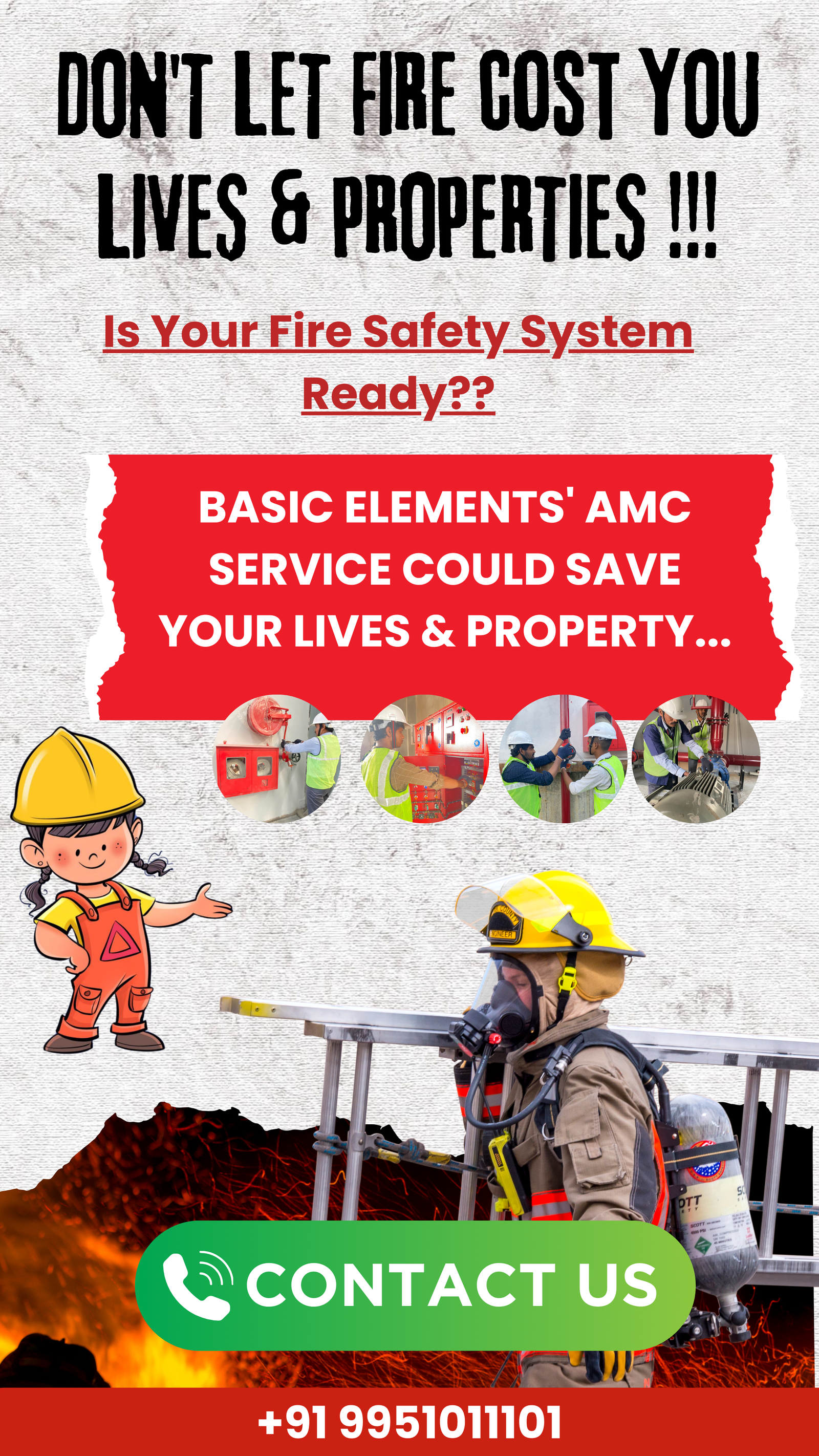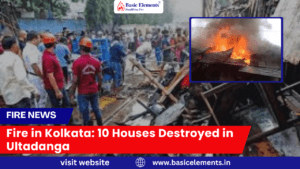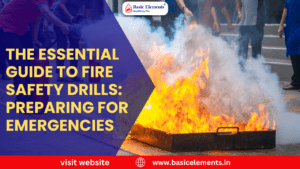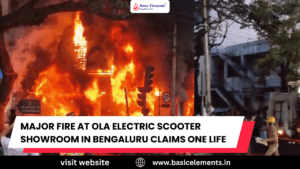Fire protection systems are essential for safeguarding lives, property, and assets from the devastating effects of fire. At Basic Elements, we specialize in providing comprehensive fire protection services tailored to meet the unique needs of our clients. This guide delves into the intricacies of fire protection systems, discussing their types, components, and the importance of regular maintenance and inspection. By understanding these systems, fire safety officers and facility managers can ensure optimal protection against fire hazards.
Understanding Fire Protection System

A fire protection system is a combination of various components designed to detect, control, and extinguish fires. These systems are crucial for mitigating fire-related risks and ensuring the safety of building occupants. Fire protection systems can be broadly classified into two categories: active fire protection systems and passive fire protection systems.
Types of Fire Protection System

1. Active Fire Protection System
Active fire protection systems require some form of action or intervention to function effectively. These systems are designed to detect fires early, alert occupants, and actively combat the spread of fire. Key components of active fire protection systems include:
Fire Alarms: Fire alarms are essential for early fire detection and alerting building occupants. These systems can include smoke detectors, heat detectors, and manual pull stations. When a fire is detected, the alarm system triggers an audible and visual alert, prompting occupants to evacuate the building.
Sprinkler Systems: Sprinkler systems are automated systems that release water to suppress and extinguish fires. They are highly effective in controlling fires in their early stages, preventing them from spreading. Sprinkler systems can be designed as wet pipe systems, dry pipe systems, deluge systems, or pre-action systems, depending on the specific requirements of the building.
Fire Extinguishers: Fire extinguishers are portable devices that allow individuals to manually combat small fires. Different types of fire extinguishers are available, including water, foam, CO2, dry powder, and wet chemical extinguishers. Proper training on the use of fire extinguishers is essential for effective fire response.
Smoke Detectors: Smoke detectors are devices that sense the presence of smoke and trigger alarms. They play a crucial role in early fire detection, especially in areas where fires are likely to start. Smoke detectors can be interconnected to provide comprehensive coverage throughout a building.
Fire Suppression Systems: Fire suppression systems use specialized agents, such as gas, foam, or chemicals, to suppress fires. These systems are commonly used in areas where water-based systems may not be suitable, such as data centers, server rooms, and kitchens. Fire suppression systems can be designed to target specific hazards and minimize collateral damage.
2. Passive Fire Protection System
Passive fire protection systems are designed to contain and prevent the spread of fires without human intervention. These systems focus on structural elements and building materials that resist fire and limit its spread. Key components of passive fire protection systems include:
Fire-Resistant Walls and Floors: Fire-resistant walls and floors are constructed using materials that can withstand high temperatures and prevent fire from spreading. These barriers compartmentalize a building, limiting the movement of fire and smoke between different areas.
Fire Doors: Fire doors are designed to automatically close in the event of a fire, creating a barrier that prevents the spread of fire and smoke. Fire doors are equipped with self-closing mechanisms and are rated based on their fire resistance duration.
Fireproofing Coatings: Fireproofing coatings are applied to structural elements, such as steel beams and columns, to enhance their fire resistance. These coatings provide an additional layer of protection, allowing structures to maintain their integrity during a fire.
Compartmentalization: Compartmentalization involves dividing a building into separate fire compartments using fire-resistant barriers. This strategy limits the spread of fire and provides safe evacuation routes for occupants. Fire compartments are designed to contain fire within a specific area, preventing it from spreading to other parts of the building.
Key Components of a Fire Protection System

A complete fire protection system consists of several vital components that work together to provide effective fire safety. Understanding these components is crucial for ensuring the system’s overall functionality and reliability. Key components of a fire protection system include:
Fire Alarms: Fire alarms are the cornerstone of any fire protection system. They detect the presence of fire and alert occupants through audible and visual signals. Modern fire alarm systems can be integrated with building management systems to provide real-time monitoring and control.
Sprinkler Heads: Sprinkler heads are the devices that release water when activated by heat. They are strategically placed throughout a building to provide optimal coverage. Different types of sprinkler heads are available, including standard response, quick response, and extended coverage sprinklers.
Control Panels: Control panels are the central hub of a fire protection system. They receive signals from detectors and sensors, activate alarms, and control other system components. Control panels provide critical information to emergency responders and facilitate coordinated fire response efforts.
Piping and Valves: Piping and valves are essential for transporting and controlling the flow of water or fire suppression agents. Proper installation and maintenance of piping and valves ensure the reliable delivery of water or agents to the appropriate areas.
Smoke and Heat Detectors: Smoke and heat detectors play a crucial role in early fire detection. Smoke detectors sense the presence of smoke particles, while heat detectors respond to temperature increases. Both types of detectors can be interconnected to provide comprehensive coverage.
Emergency Lighting: Emergency lighting ensures visibility during power outages or emergencies. It illuminates evacuation routes and critical areas, guiding occupants to safety. Emergency lighting systems are equipped with backup power sources to ensure continuous operation.
Exit Signage: Exit signage provides clear guidance to evacuation routes and emergency exits. These signs are strategically placed throughout a building to ensure that occupants can quickly and safely exit during an emergency
Fire Protection System Types

1. Water-Based Systems
Water-based fire protection systems are among the most common and effective methods for controlling fires. These systems use water as the primary extinguishing agent and can be configured in various ways to meet specific needs. Common types of water-based systems include:
Wet Pipe Systems: Wet pipe systems are the most prevalent type of sprinkler system. In these systems, the pipes are always filled with water, ready for immediate discharge when a sprinkler head is activated. Wet pipe systems are suitable for buildings where the risk of freezing is low.
Dry Pipe Systems: Dry pipe systems contain air or nitrogen in the pipes instead of water. When a sprinkler head is activated, the air is expelled, allowing water to flow into the pipes and be discharged. Dry pipe systems are ideal for buildings in cold climates where the risk of freezing is high.
Deluge Systems: Deluge systems are similar to wet pipe systems but with open nozzles that release water simultaneously when a fire is detected. These systems are used in high-hazard areas where rapid water discharge is necessary to control fires.
Pre-Action Systems: Pre-action systems require a secondary trigger, such as a heat detector, to activate the system. These systems are commonly used in areas where accidental water discharge must be prevented, such as data centers and museums.
2. Non-Water-Based Systems
Non-water-based fire protection systems use alternative extinguishing agents, such as gas, foam, or dry chemicals, to suppress fires. These systems are suitable for specific environments where water may not be effective or could cause damage. Common types of non-water-based systems include:
Gas Suppression Systems: Gas suppression systems use inert gases, such as CO2 or FM-200, to extinguish fires by displacing oxygen or disrupting the chemical reactions of combustion. These systems are ideal for protecting sensitive equipment and valuable assets in areas like data centers and server rooms.
Foam Systems: Foam systems use a mixture of water and foam concentrate to create a foam blanket that smothers and cools fires. These systems are effective for controlling flammable liquid fires and are commonly used in industrial facilities, warehouses, and airports.
Powder Systems: Powder systems use dry chemical agents to suppress fires by interrupting the chemical reactions of combustion. These systems are suitable for various fire types, including flammable liquids and electrical fires. Dry powder extinguishers are commonly found in commercial kitchens and industrial settings.
Maintaining and Inspecting Fire Protection Systems
Proper maintenance and inspection are crucial for ensuring that fire protection systems function effectively during an emergency. A comprehensive maintenance and inspection program includes regular checks, testing, and servicing of all system components. The following checklist outlines key maintenance and inspection tasks for fire protection systems:
Fire Protection System Checklist:
Regular Maintenance:
Fire Alarms: Test and inspect fire alarms and detectors regularly to ensure they are operational. Replace batteries and faulty components as needed.
Sprinkler Systems: Inspect and test sprinkler heads, control valves, and piping for leaks, corrosion, and blockages. Ensure that sprinkler heads are free of obstructions and positioned correctly.
Fire Extinguishers: Check fire extinguishers for proper pressure, intact seals, and no visible damage. Refill or replace extinguishers as necessary.
Smoke Detectors: Test smoke detectors and replace batteries regularly. Clean detectors to remove dust and debris that could affect their sensitivity.
Emergency Lighting: Inspect emergency lighting systems to ensure they function correctly. Test backup power sources and replace any faulty components.
Exit Signage: Verify that exit signs are visible, illuminated, and properly positioned. Replace any damaged or non-functioning signs.
Frequent Inspections:
Visual Inspections: Conduct visual inspections of all fire protection system components to identify any obvious signs of damage, wear, or obstruction.
Functional Tests: Perform functional tests on fire alarms, detectors, and control panels to ensure they operate correctly. Verify that alarm signals are transmitted to monitoring centers.
Sprinkler Flow Tests: Conduct flow tests on sprinkler systems to confirm they can deliver the required water flow and pressure. Ensure that control valves open and close properly.
Fire Doors: Inspect fire doors for proper operation, including self-closing mechanisms and door seals. Ensure that doors close completely and latch securely.
Fireproofing Coatings: Check the condition of fireproofing coatings on structural elements. Reapply coatings as necessary to maintain their effectiveness.
Periodic Testing:
System Activation Tests: Perform activation tests on fire suppression systems to verify their response to fire signals. Ensure that suppression agents are discharged correctly.
Evacuation Drills: Conduct regular evacuation drills to ensure that occupants are familiar with emergency procedures and can evacuate quickly and safely.
Pressure Testing: Test the pressure of fire protection system piping to ensure there are no leaks or weak points. Repair any identified issues promptly.
Compartmentalization Checks: Verify that fire compartments are intact and that barriers, such as fire-resistant walls and doors, are in good condition.
Repair and Replacement:
Address Leaks and Damages: Promptly repair any leaks, damages, or malfunctions identified during inspections and tests. Ensure that repairs are carried out by qualified technicians.
Replace Faulty Components: Replace outdated or faulty components, such as detectors, sprinkler heads, and control panels, to ensure the system’s reliability.
System Upgrades: Upgrade fire protection systems to comply with the latest fire safety standards and regulations. Consider integrating new technologies to enhance system performance.
Integrating Fire Protection System with Other Safety Measures

A comprehensive fire safety strategy requires integrating fire protection systems with other critical measures to ensure a coordinated and effective response during emergencies. Key areas of integration include:
Fire Safety Plans: A detailed fire safety plan should include maps showing the location of fire protection system components, such as alarms, sprinklers, and extinguishers. The plan should outline evacuation routes, assembly points, and procedures for different fire scenarios.
Fire Drills: Regular fire drills are essential for ensuring that occupants are familiar with emergency procedures and can evacuate quickly and safely. Drills should simulate various fire scenarios and involve coordination with local fire departments and emergency responders.
Training: Proper training is crucial for ensuring that building occupants and staff know how to use fire protection system components effectively. Training should cover the use of fire extinguishers, alarm systems, and evacuation procedures. Specialized training may be required for staff responsible for operating and maintaining fire protection systems.
Regular Audits: Conduct regular audits of fire protection systems to assess their effectiveness and compliance with fire safety regulations. Audits should include a review of maintenance records, inspection reports, and system performance data. Identify areas for improvement and implement corrective actions promptly.
Conclusion
At Basic Elements, we emphasize the importance of a well-designed and maintained fire protection system. By understanding the types, components, and maintenance requirements of fire protection systems, you can ensure optimal safety for your facility. Trust Basic Elements for comprehensive fire protection services that keep you prepared and protected against fire hazards.
For more information or to schedule a consultation, visit our website or contact us directly. Stay safe with Basic Elements – your partner in fire protection.








1 thought on “Understanding Fire Protection System: Types, Components, and Maintenance”
Pingback: Comprehensive Guide to Fire Alarm Systems: Types, Addressable Systems, and Testing - Basic Elements
Comments are closed.